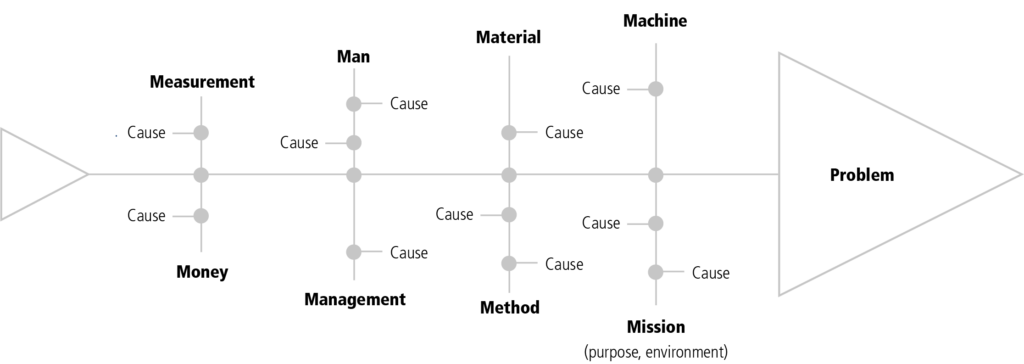You’re managing a project when suddenly you come across a problem you have to solve as fast as possible? Let us introduce you to an ingenious lean management method that’ll help you get to where you want to be: the Ishikawa diagram. It’s a graphical representation of all possible causes of a problem and their interdependencies. The method was invented in the 1940s by Japanese researcher Kaoru Ishikawa, and helps to better understand causes and their effects.
You’ll use a visual problem-solving process to perform an analytical search for the causes of an existing problem. This involves steadily breaking down the problem’s primary causes until you reach the root cause(s) – hence the term “root-cause analysis”. This method is especially suitable for group work and can be implemented as a brainstorming exercise.
In visual terms, an Ishikawa diagram resembles the skeleton of a fish, with backbone and ribs. The starting point is a horizontal line (“backbone”) pointing to the problem definition on the right (“head”). The problem should be defined as clearly and succinctly as possible. Then the possible causes are listed along the “ribs” that branch vertically off the backbone. Predefined categories provide a useful framework; one popular method is the 8 Ms:
Man, Material, Machine, Method, Mission, Management, Measurement, Money
These categories are merely intended as a guideline. It’s important to focus on your specific problem and adapt the categories on the main branches accordingly.


When assigning causes to each main branch or rib, describe them as specifically as possible, breaking them down into sub-branches if necessary. As a rule, you’ll need to review each cause several times to identify the problem’s root cause(s). Once you’ve identified the roots, you can tackle them with confidence.
Now you need to arrange the causes you and your colleagues have identified in order of priority. Which causes are most likely to have a concrete bearing on the problem? Which are more likely to be secondary? This is the stage at which you identify the primary cause – in exceptional cases, you may be able to isolate multiple primary causes.
The final stage involves using the selected primary causes to work out specific courses of action and approaches so you can eliminate the problem once and for all and avoid future recurrences. Don’t put off this vital step! There’s always a risk that you’ll lose sight of the true solution to the problem.
Lean management is a holistic principle for streamlining a company’s entire value chain using a number of different methods. Processes are precisely coordinated and optimised; any superfluous activities are avoided. The Ishikawa diagram and many other useful methods feature in our new online training course. The format also offers you the flexibility you need at the present time – because you can take part in our online sessions from the comfort of your own home! The next iteration of the programme starts in March 2021.